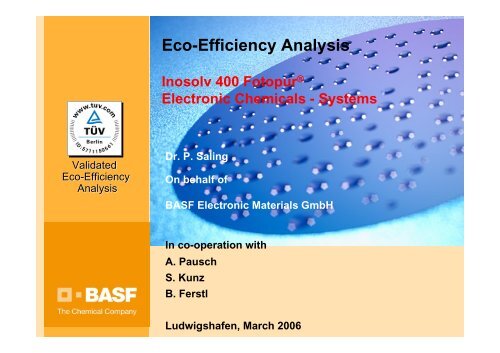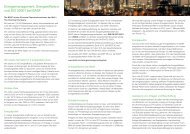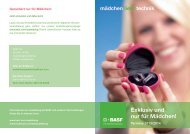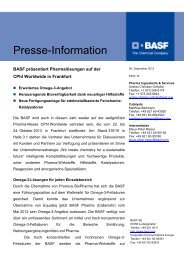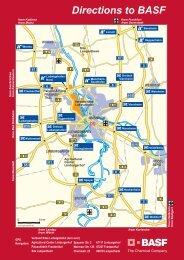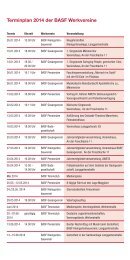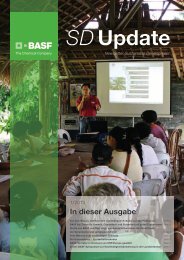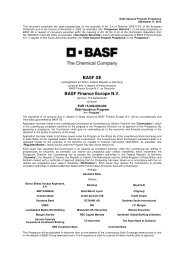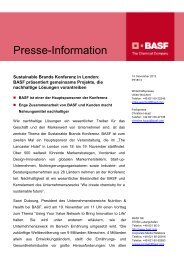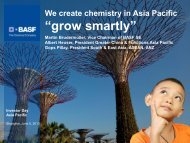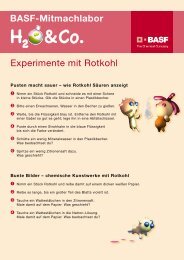Inosolv 400 Fotopur - BASF.com
Inosolv 400 Fotopur - BASF.com
Inosolv 400 Fotopur - BASF.com
You also want an ePaper? Increase the reach of your titles
YUMPU automatically turns print PDFs into web optimized ePapers that Google loves.
Validated<br />
Eco-Efficiency<br />
Eco Efficiency<br />
Analysis<br />
Eco-Efficiency Analysis<br />
<strong>Inosolv</strong> <strong>400</strong> <strong>Fotopur</strong> ®<br />
Electronic Chemicals - Systems<br />
Dr. P. Saling<br />
On behalf of<br />
<strong>BASF</strong> Electronic Materials GmbH<br />
In co-operation with<br />
A. Pausch<br />
S. Kunz<br />
B. Ferstl<br />
Ludwigshafen, March 2006
Summary<br />
� The eco-efficiency study was prepared to <strong>com</strong>pare different alternatives for cleaning wafers with<br />
post plasma etch residues with different chemicals for the electronic industry. The alternative in<br />
focus is <strong>Inosolv</strong> <strong>400</strong> <strong>Fotopur</strong> as a new cleaning agent for this application It is not only the price<br />
and environmental impact of the alternative materials, which are important to the <strong>com</strong>parison. A<br />
life-cycle view should identify the strengths and weaknesses of the different alternatives.<br />
� The most eco-efficient alternative was the “<strong>Inosolv</strong> <strong>400</strong> <strong>Fotopur</strong>”-Alternative. This alternative is<br />
much more better due to costs and environmental performance than all the other alternatives<br />
under investigation. The distance to them was robust and significantly.<br />
� The use of the <strong>Inosolv</strong> system is much more sustainable than all the others under investigation<br />
and have a lot of potentials for further development to increase their sustainability in the future.<br />
Dr. P. Saling, GUP/CE, Electronic Chemicals, Systems-CR, 31/03/2006<br />
2
Third party opinion<br />
8. Summary<br />
For a <strong>com</strong>parison of alternatives for cleaning wafers with post plasma etch residues for the electronic<br />
industry with the Eco-Efficiency Analysis „Removal of post plasma etch residues of 10.000 wafers in a<br />
batch process“ , a “Critical Review” was performed according to DIN EN ISO 14040:1997.<br />
The certified Eco-Efficiency Analysis (“<strong>BASF</strong>-method”) and qualified data were used to assess three<br />
alternatives and calculate their eco-efficiency.<br />
All steps and the analysis were calculated by using the <strong>BASF</strong> methodology. The single results and the<br />
generated overall result are accurately made and correct. Some minor changes were discussed due to<br />
ecotoxicological data and are mentioned in the final version of March 31st, 2006.<br />
The result shows lower costs and a significantly better Eco-Efficiency for the <strong>Inosolv</strong> <strong>400</strong> <strong>Fotopur</strong> system<br />
according to the other alternatives under investigation in the batch cleaning process.<br />
Köln, den 31.03.06<br />
Bernhard Priesemuth Dr. C. Lutermann<br />
Dr. P. Saling, GUP/CE, Electronic Chemicals, Systems-CR, 31/03/2006<br />
3
Certification with the Eco-Efficiency Label<br />
Label Eco-Efficiency Analysis<br />
Requirements<br />
<strong>BASF</strong> AG has developed a new label for products that have been evaluated by an Eco-<br />
Efficiency Analysis. The awarding of the label is dependent on demanding requirements:<br />
After realisation of the analysis a third party evaluation (critical review) is requested.<br />
Furthermore, publication of the results of the analysis will be undertaken via internet.<br />
The label can be carried on for three years. After that period, a revision of the analysis is<br />
required due to cover market developments and product diversity.<br />
1. Ac<strong>com</strong>plished Eco-Efficiency Analysis according to the methodology<br />
certified by TÜV Rheinland/ Berlin-Brandenburg, Germany.<br />
2. Verification of the investigated product to be more eco-efficient for the<br />
defined customer benefit than other alternatives as result of the analysis.<br />
3. Presentation of a third party evaluation (so-called Critical Review<br />
according ISO 14040 ff.).<br />
4. Publication of the results via internet on website www.oeea.de, which is<br />
referred to on the label.<br />
5. Payment of the licence fee for the duration of three years (s. price list).<br />
Dr. P. Saling, GUP/CE, Electronic Chemicals, Systems-CR, 31/03/2006<br />
4
Introduction I, general remarks<br />
� Only a Batch-process for the wafer cleaning is assessed in the study.<br />
� In the study Spray Tool processes are calculated in the base case.<br />
� Aqueous systems do not need explosives protection devices.<br />
� The wafers will be cleaned in packages of 25 pieces.<br />
� Time savings during the process will not be linked in the first approach with investment costs.<br />
Dr. P. Saling, GUP/CE, Electronic Chemicals, Systems-CR, 31/03/2006<br />
5
Objectives and Use of the Eco-Efficiency<br />
Study<br />
Validated<br />
Eco-Efficiency<br />
Analysis method<br />
� The study was made to <strong>com</strong>pare different alternatives for cleaning wafers with post plasma<br />
etch residues with different chemicals for the electronic industry. The alternative in focus is<br />
<strong>Inosolv</strong> <strong>400</strong> <strong>Fotopur</strong> as a new cleaning agent for this application It is not only the price and<br />
environmental impact of the alternative materials, which are important to the <strong>com</strong>parison. A<br />
life-cycle view should identify the strengths and weaknesses of the different alternatives.<br />
� The study used the methodology of the eco-efficiency analysis, developed by <strong>BASF</strong> as a<br />
life-cycle tool to show and assess different parts of the life-cycle of the chemical reactions<br />
and related materials which are required to achieve the desired product. It is one method<br />
between others that are able to assess environmental data over the whole life cycle.<br />
� The ecological calculations of the single results in each category are following the ISO-rules<br />
14040 ff in the main points. The quantitative weighting step to get the ecological fingerprint<br />
and the portfolio are not covered with the ISO-rules. The eco-efficiency analysis has more<br />
features than are mentioned in the ISO rules.<br />
� The methodology has been approved by the German TUV. This methodology was used by<br />
the "Öko-Institut - Institute for applied ecology" in Freiburg Germany in different APMEstudies.<br />
Öko-Institut uses a quite similar methodology with a different weighting system<br />
("Ecograde"). . TNO in the Netherlands using the <strong>BASF</strong> standard method with a different<br />
weighting system. The Wuppertal Institute accepts the method: “Basically, the large number<br />
of indicators used in the eco-efficiency analysis of <strong>BASF</strong> make relatively reliable statements<br />
possible …“. The method was initially developed by <strong>BASF</strong> and Roland Berger Consulting,<br />
Munich.<br />
Dr. P. Saling, GUP/CE, Electronic Chemicals, Systems-CR, 31/03/2006<br />
6
Limits and Reglementation for the use of<br />
the Results<br />
� Results are valid for materials in the defined applications. They are not valid for different applications,<br />
which have nothing to do with the original process defined in the study.<br />
� The “cradle-to-grave” view focuses on all steps of the cleaning process. Steps before and after this<br />
process step are not considered.<br />
� The protection and safety issues for workplaces are calculated in this study following the German Law<br />
and regulation.<br />
� Further information on the eco efficiency methodology: http://www.oekoeffizienzanalyse.de<br />
Dr. P. Saling, GUP/CE, Electronic Chemicals, Systems-CR, 31/03/2006<br />
7
Definition of Alternatives, Definition of the “User benefit”<br />
as reference to all following graphs where UB is mentioned<br />
as an abbreviation.<br />
User benefit<br />
Removal of post<br />
plasma etch<br />
residues of<br />
10.000 wafers in<br />
a batch process<br />
(8 inch<br />
equivalents) per<br />
month<br />
Alternative in focus<br />
• <strong>Inosolv</strong> <strong>400</strong><br />
<strong>Fotopur</strong>®<br />
Alternatives<br />
• Products A&B<br />
• Product C<br />
Dr. P. Saling, GUP/CE, Electronic Chemicals, Systems-CR, 31/03/2006<br />
8
System Boundaries:<br />
<strong>Inosolv</strong> <strong>400</strong> <strong>Fotopur</strong><br />
Water<br />
Remover<br />
<strong>com</strong>position<br />
Production<br />
Wafer with<br />
post plasma<br />
etch residues<br />
Electricity<br />
Use<br />
Cleaning<br />
Solvent<br />
Cleaning Step 1<br />
Washing<br />
Drying<br />
Recycling<br />
Used Cleaning<br />
solvent reservoir<br />
Filtration<br />
Water emissions<br />
Incineration/<br />
Wastes<br />
Dr. P. Saling, GUP/CE, Electronic Chemicals, Systems-CR, 31/03/2006<br />
9
System Boundaries:<br />
Products A&B<br />
Water<br />
Remover<br />
<strong>com</strong>position<br />
Production<br />
Wafer with<br />
post plasma<br />
etch residues<br />
Iso-Propanol<br />
Electricity<br />
Sodium hydroxide<br />
Use<br />
Cleaning<br />
Solvent<br />
Cleaning Step 1<br />
Cleaning Step 2<br />
Remove of solvent<br />
Washing<br />
Drying<br />
Recycling<br />
Used Cleaning<br />
solvent reservoir<br />
Filtration<br />
Air emissions<br />
Water emissions<br />
Incineration/<br />
Wastes<br />
Dr. P. Saling, GUP/CE, Electronic Chemicals, Systems-CR, 31/03/2006 10
System Boundaries:<br />
Product C<br />
Water<br />
Remover<br />
<strong>com</strong>position<br />
Production<br />
Wafer with<br />
post plasma<br />
etch residues<br />
Iso-Propanol<br />
Electricity<br />
Sodium hydroxide<br />
Use<br />
Cleaning<br />
Solvent<br />
Cleaning Step 1<br />
Cleaning Step 2<br />
Remove of solvent<br />
Washing<br />
Drying<br />
Recycling<br />
Used Cleaning<br />
solvent reservoir<br />
Filtration<br />
Air emissions<br />
Water emissions<br />
Incineration/<br />
Wastes<br />
Dr. P. Saling, GUP/CE, Electronic Chemicals, Systems-CR, 31/03/2006 11
Data sources and quality of data sources<br />
Definition of qualities<br />
Very high:<br />
Direct access to data,<br />
internal and verified data,<br />
validity check is possible<br />
High:<br />
Direct access to data,<br />
internal and verified data<br />
with some uncertainties<br />
Medium high:<br />
No direct access to data,<br />
external data with some<br />
uncertainties<br />
Low:<br />
No direct access to data,<br />
external data with a lot of<br />
uncertainties<br />
Field Source Quality Year Valid for<br />
Chemical <strong>BASF</strong>, internal data from very high to<br />
processes<br />
Chemical<br />
production, benchmark high 2005 Germany<br />
processes <strong>BASF</strong>, internal data from very high to<br />
cleaning production<br />
high 2005 Germany<br />
<strong>BASF</strong>, internal data, Boustead very high to 2000-<br />
Precursors database<br />
high<br />
2005 Worldwide<br />
<strong>BASF</strong>, internal data, Boustead high to<br />
Auxillaries database<br />
medium high 2004 Worldwide<br />
Germany,<br />
Effluents, <strong>BASF</strong>, internal data, Boustead very high to<br />
Ludwigshaf<br />
Energy database<br />
high 2005 en<br />
Germany,<br />
Reycycling <strong>BASF</strong>, internal data from very high to<br />
Ludwigshaf<br />
processes production<br />
high 2005 en<br />
Recycling<br />
Germany,<br />
processes <strong>BASF</strong>, internal data from<br />
1994- Ludwigshaf<br />
solvents production high<br />
2004 en<br />
Dr. P. Saling, GUP/CE, Electronic Chemicals, Systems-CR, 31/03/2006 12
Results<br />
Dr. P. Saling, GUP/CE, Electronic Chemicals, Systems-CR, 31/03/2006 13
Base Case: Portfolio of Alternatives for<br />
Wafer Cleaning processes<br />
User<br />
benefit:<br />
Removal of post<br />
plasma etch<br />
residues of 10.000<br />
wafers in a batch<br />
process<br />
(8 inch<br />
equivalents) per<br />
month<br />
Sector of significant<br />
differences<br />
Environment (normalized)<br />
0,4<br />
1,0<br />
1,6<br />
1,6<br />
Low eco-efficiency<br />
1,0<br />
Costs (normalized)<br />
High eco-efficiency<br />
0,4<br />
<strong>Inosolv</strong> <strong>400</strong><br />
<strong>Fotopur</strong>®<br />
Products A&B<br />
Product C<br />
The most ecoefficient<br />
alternative in the<br />
Base case is the<br />
<strong>Inosolv</strong> <strong>400</strong><br />
Dr. P. Saling, GUP/CE, Electronic Chemicals, Systems-CR, 31/03/2006 14
Interpretation of the Eco-Efficiency<br />
Portfolio<br />
� The most eco-efficient alternatives is the <strong>Inosolv</strong> <strong>400</strong> <strong>Fotopur</strong><br />
system. With a major distance, the alternative Product C follows.<br />
The lowest Eco-Efficiency is detected for the Products A&B.<br />
� The best environmental position is found for <strong>Inosolv</strong> <strong>400</strong> <strong>Fotopur</strong>,<br />
the worst for Products A&B.<br />
� The best cost position is found for <strong>Inosolv</strong> <strong>400</strong> <strong>Fotopur</strong>, the worst<br />
for Product C and followed by Products A&B.<br />
Dr. P. Saling, GUP/CE, Electronic Chemicals, Systems-CR, 31/03/2006 15
Total costs<br />
Euro/UB<br />
60000<br />
50000<br />
<strong>400</strong>00<br />
30000<br />
20000<br />
10000<br />
0<br />
<strong>Inosolv</strong> <strong>400</strong><br />
<strong>Fotopur</strong>®<br />
Products A&B Products A&B<br />
Waste water<br />
Drum Handling, Drum processes<br />
Customer's Evaluation Costs<br />
Wastes, Effluents, Recycling<br />
Energy and water use<br />
Packaging and transportation<br />
Solvents<br />
Remover<br />
Remark: “UB” means in<br />
all graphs “User<br />
Benefit”, which was<br />
defined in the user<br />
benefit definition at the<br />
beginning of the study!<br />
Dr. P. Saling, GUP/CE, Electronic Chemicals, Systems-CR, 31/03/2006 16
Ecology Fingerprint of <strong>BASF</strong><br />
Area use<br />
Resources consumption<br />
Energy consumption<br />
1,00<br />
0,50<br />
0,00<br />
Risk potential<br />
Emissions<br />
Toxicity potential<br />
<strong>Inosolv</strong> <strong>400</strong> <strong>Fotopur</strong>®<br />
Products A&B<br />
Product C<br />
1,0 = worst position, better<br />
results ordered relatively<br />
Interpretation of the Ecological<br />
Fingerprint<br />
� The best environmental performance was detected for the<br />
alternative <strong>Inosolv</strong> <strong>400</strong> <strong>Fotopur</strong>. With a major distance, the<br />
alternatives Products A&B and Product C are following and have<br />
the worst ecological position.<br />
� It was shown the significant better performance due to the<br />
environment of the <strong>Fotopur</strong> systems.<br />
� The most differentiating categories between the alternatives with a<br />
low ecological performance are the risk- and the toxicity potential.<br />
Dr. P. Saling, GUP/CE, Electronic Chemicals, Systems-CR, 31/03/2006 18
Results of the<br />
Environmental Evaluation<br />
Dr. P. Saling, GUP/CE, Electronic Chemicals, Systems-CR, 31/03/2006 19
Energy consumption<br />
MJ/UB<br />
500000<br />
<strong>400</strong>000<br />
300000<br />
200000<br />
100000<br />
0<br />
-100000<br />
-200000<br />
<strong>Inosolv</strong> <strong>400</strong><br />
<strong>Fotopur</strong>®<br />
Products A&B Product C<br />
Wastes, Effluents, Recycling<br />
Energy and water use<br />
Packaging and transportation<br />
Solvents<br />
Remover<br />
Dr. P. Saling, GUP/CE, Electronic Chemicals, Systems-CR, 31/03/2006 20
Comparison of Resource Consumption<br />
kg/(a*Mio t) 1/2 /UB<br />
3000<br />
2500<br />
2000<br />
1500<br />
1000<br />
500<br />
0<br />
-500<br />
<strong>Inosolv</strong> <strong>400</strong> <strong>Fotopur</strong>® Products A&B Product C<br />
Sand<br />
Bauxite<br />
Limestone<br />
Iron ore<br />
Phosphate<br />
Sulfur<br />
NaCl<br />
Lignite<br />
Gas<br />
Oil<br />
Coal<br />
Dr. P. Saling, GUP/CE, Electronic Chemicals, Systems-CR, 31/03/2006 21
Air Emissions:<br />
Global Warming Potential (GWP)<br />
g CO2-equivalent/UB<br />
30000000<br />
25000000<br />
20000000<br />
15000000<br />
10000000<br />
5000000<br />
0<br />
<strong>Inosolv</strong> <strong>400</strong> <strong>Fotopur</strong>® Products A&B Product C<br />
Wastes,<br />
Effluents,<br />
Recycling<br />
Energy and<br />
water use<br />
Packaging and<br />
transportation<br />
Solvents<br />
Remover<br />
Dr. P. Saling, GUP/CE, Electronic Chemicals, Systems-CR, 31/03/2006 22
Air Emissions:<br />
Summer smog (POCP)<br />
g Ethen-equivalent/UB<br />
16000<br />
1<strong>400</strong>0<br />
12000<br />
10000<br />
8000<br />
6000<br />
<strong>400</strong>0<br />
2000<br />
0<br />
-2000<br />
<strong>Inosolv</strong> <strong>400</strong> <strong>Fotopur</strong>® Products A&B Product C<br />
Wastes,<br />
Effluents,<br />
Recycling<br />
Energy and<br />
water use<br />
Packaging and<br />
transportation<br />
Solvents<br />
Remover<br />
Dr. P. Saling, GUP/CE, Electronic Chemicals, Systems-CR, 31/03/2006 23
Air Emissions:<br />
Acidification Potential (AP)<br />
g SO2-equivalent/UB<br />
1<strong>400</strong>00<br />
120000<br />
100000<br />
80000<br />
60000<br />
<strong>400</strong>00<br />
20000<br />
0<br />
<strong>Inosolv</strong> <strong>400</strong> <strong>Fotopur</strong>® Products A&B Product C<br />
Wastes, Effluents,<br />
Recycling<br />
Energy and water<br />
use<br />
Packaging and<br />
transportation<br />
Solvents<br />
Remover<br />
Dr. P. Saling, GUP/CE, Electronic Chemicals, Systems-CR, 31/03/2006 24
Air Emissions:<br />
Ozone Depletion Potential (ODP)<br />
g CFCs-equivalent/UB<br />
7,00<br />
6,00<br />
5,00<br />
4,00<br />
3,00<br />
2,00<br />
1,00<br />
0,00<br />
<strong>Inosolv</strong> <strong>400</strong> <strong>Fotopur</strong>® Products A&B Product C<br />
Wastes, Effluents, Recycling<br />
Energy and water use<br />
Packaging and transportation<br />
Solvents<br />
Remover<br />
Dr. P. Saling, GUP/CE, Electronic Chemicals, Systems-CR, 31/03/2006 25
Water Emissions<br />
critical waste water volume l /UB<br />
2500000<br />
2000000<br />
1500000<br />
1000000<br />
500000<br />
0<br />
<strong>Inosolv</strong> <strong>400</strong><br />
<strong>Fotopur</strong>®<br />
Products A&B Product C<br />
Wastes, Effluents, Recycling<br />
Energy and water use<br />
Packaging and transportation<br />
Solvents<br />
Remover<br />
Dr. P. Saling, GUP/CE, Electronic Chemicals, Systems-CR, 31/03/2006 26
Normalized Wastes<br />
kg/UB<br />
700<br />
600<br />
500<br />
<strong>400</strong><br />
300<br />
200<br />
100<br />
0<br />
<strong>Inosolv</strong> <strong>400</strong> <strong>Fotopur</strong>® Products A&B Product C<br />
Wastes, Effluents, Recycling<br />
Energy and water use<br />
Packaging and transportation<br />
Solvents<br />
Remover<br />
Dr. P. Saling, GUP/CE, Electronic Chemicals, Systems-CR, 31/03/2006 27
Toxicity Potential - Production<br />
Toxicity Evalution points/UB<br />
16000000<br />
1<strong>400</strong>0000<br />
12000000<br />
10000000<br />
8000000<br />
6000000<br />
<strong>400</strong>0000<br />
2000000<br />
0<br />
<strong>Inosolv</strong> <strong>400</strong> <strong>Fotopur</strong>® Products A&B Product C<br />
Sodium hydroxide<br />
Solvents<br />
Remover<br />
Dr. P. Saling, GUP/CE, Electronic Chemicals, Systems-CR, 31/03/2006 28
Toxicity Potential – Use of the products<br />
Toxicity Evalution points/UB<br />
9000<br />
8000<br />
7000<br />
6000<br />
5000<br />
<strong>400</strong>0<br />
3000<br />
2000<br />
1000<br />
0<br />
<strong>Inosolv</strong> <strong>400</strong> <strong>Fotopur</strong>® Products A&B Product C<br />
Sodium hydroxide<br />
Solvents<br />
Remover<br />
Dr. P. Saling, GUP/CE, Electronic Chemicals, Systems-CR, 31/03/2006 29
Eco-Toxicity Potential<br />
Eco-Toxicity Evalution points/UB<br />
900<br />
800<br />
700<br />
600<br />
500<br />
<strong>400</strong><br />
300<br />
200<br />
100<br />
0<br />
<strong>Inosolv</strong> <strong>400</strong> <strong>Fotopur</strong>® Products A&B Product C<br />
Ecotox Recycling<br />
Ecotox Use<br />
Dr. P. Saling, GUP/CE, Electronic Chemicals, Systems-CR, 31/03/2006 30
Risk Potential - Production<br />
Risk evaluation factors<br />
2500<br />
2000<br />
1500<br />
1000<br />
500<br />
0<br />
<strong>Inosolv</strong> <strong>400</strong> <strong>Fotopur</strong>® Products A&B Product C<br />
Danger of<br />
Explosion<br />
Working and<br />
Working related<br />
Accidents, Truck<br />
Shipping<br />
Working and<br />
Working related<br />
Accidents, Oil and<br />
Gas Industry<br />
Working and<br />
Working related<br />
Accidents,<br />
Chemical Industry<br />
Dr. P. Saling, GUP/CE, Electronic Chemicals, Systems-CR, 31/03/2006 31
Risk Potential – Use phase<br />
Risk evaluation factors<br />
16000<br />
1<strong>400</strong>0<br />
12000<br />
10000<br />
8000<br />
6000<br />
<strong>400</strong>0<br />
2000<br />
0<br />
<strong>Inosolv</strong> <strong>400</strong> <strong>Fotopur</strong>® Products A&B Product C<br />
Workers Deseases,<br />
Computer Ind.<br />
Working and<br />
Working related<br />
Accidents,<br />
Computer Ind.<br />
Danger of Fire<br />
Danger of<br />
Explosion<br />
Dr. P. Saling, GUP/CE, Electronic Chemicals, Systems-CR, 31/03/2006 32
Use of Area<br />
Weighted Area Use m²a /UB<br />
1200<br />
1000<br />
800<br />
600<br />
<strong>400</strong><br />
200<br />
0<br />
<strong>Inosolv</strong> <strong>400</strong> <strong>Fotopur</strong>® Products A&B Product C<br />
Wastes, Effluents, Recycling<br />
Energy and water use<br />
Packaging and transportation<br />
Solvents<br />
Remover<br />
Dr. P. Saling, GUP/CE, Electronic Chemicals, Systems-CR, 31/03/2006 33
Glossary<br />
Dr. P. Saling, GUP/CE, Electronic Chemicals, Systems-CR, 31/03/2006 34
Glossary of Abbreviations and<br />
Technical Terms I<br />
AOX: abbr. for adsorbable organic halogen, a category of water emissions<br />
AP: abbr. for acidification potential or acid rain. In this impact category, the effects of air<br />
emissions that lower the local pH values of soils and can thus e.g. cause forest death<br />
are taken into account.<br />
BOD: abbr. for biological oxygen demand. This is a method for determining wastewater<br />
loads.<br />
CB: abbr. for user benefit. All impacts (costs, environment) are specific to this user benefit<br />
which all alternatives being evaluated have to fulfill.<br />
CH 4 : abbr. for methane.<br />
Cl - : abbr. for chloride.<br />
COD: abbr. for chemical oxygen demand. This is a method for determining wastewater.<br />
loads.<br />
CO 2 : abbr. for carbon dioxide.<br />
critical volume: operand for assessing the extent to which wastewater is polluted by<br />
mathematically diluting the wastewater with fresh water until the allowed limit value is<br />
reached. This volume of fresh water that has been added is referred to as the critical<br />
volume.<br />
Dr. P. Saling, GUP/CE, Electronic Chemicals, Systems-CR, 31/03/2006 35
Glossary of Abbreviations and<br />
Technical Terms II<br />
municipal waste: waste that may be deposited on a normal household landfill.<br />
emissions: emissions are categorized as emissions into air, water and soil. These broad<br />
groupings are further subdivided into more specific categories.<br />
energy unit: energy is expressed in Megajoules (MJ). 1 MJ is equivalent to 3.6 kilowatt<br />
hours (kWh).<br />
feedstock: the energy content that is bound in the materials used and can be used e.g. in<br />
incineration processes.<br />
GWP: abbr. for global warming potential, the greenhouse effect. This impact category<br />
takes into account the effects of air emissions that lead to global warming of the<br />
earth’s surface.<br />
hal. HC: abbr. for halogenated hydrocarbons.<br />
halogenated NM VOC: abbr. for halogenated non-methane volatile hydrocarbons.<br />
HC: abbr. for various hydrocarbons or hydrocarbon emissions into water.<br />
HCl: abbr. for hydrogen chloride.<br />
HM: abbr. for heavy metals.<br />
Dr. P. Saling, GUP/CE, Electronic Chemicals, Systems-CR, 31/03/2006 36
Glossary of Abbreviations and<br />
Technical Terms III<br />
impact potential: name of an operand that mathematically takes into account the impact<br />
of an emission on a defined <strong>com</strong>partment of the environment.<br />
material consumption: in this category, the consumption of raw materials is considered<br />
along with worldwide consumption and remaining reserves. Thus, a raw material with<br />
smaller reserves or greater worldwide consumption rates is more critically weighted.<br />
NH 3 : abbr. for ammonia emissions.<br />
NH 4 + : abbr. for emissions of ammonium into water.<br />
NM VOC: abbr. for non-methane volatile organic <strong>com</strong>pound.<br />
N 2 O: abbr. for N 2 O emissions.<br />
NO x : abbr. for various nitrogen oxides.<br />
normalization: in the eco-efficiency analysis, the worst performance in each ecological<br />
category is normalized to a value of one. Thus alternatives with better performance in<br />
that category will lie between zero and one on the ecological fingerprint.<br />
ODP: abbr. for ozone depletion potential, damage to the ozone layer. This impact category<br />
takes into account the effects of air emissions that lead to the destruction of the ozone<br />
layer of the upper layers of air and thus to an increase in UV radiation.<br />
Dr. P. Saling, GUP/CE, Electronic Chemicals, Systems-CR, 31/03/2006 37
Glossary of Abbreviations and<br />
Technical Terms IV<br />
PO 4 3- : abbr. for emissions of phosphate into water.<br />
POCP: abbr. for photochemical ozone creation potential. This effect category takes into<br />
account the effects of local emissions that lead to an increase in ozone close to the<br />
ground and thus contribute to what is known as summer smog.<br />
risk potential: impact category assessing the effects of risk factors over the <strong>com</strong>plete life<br />
cycle. Risks such as transportation risks, dangers of explosion, dangers of accidents,<br />
etc. may be included<br />
SO x : abbr. for various sulfur dioxides.<br />
SO 4 2- : abbr. for emissions of sulfates into water.<br />
special waste: waste that has to be deposited on a special landfill.<br />
system boundary: determines what aspects are considered in the study.<br />
Time span: The period for which a raw material is still available and can be used. The<br />
current use of the raw material in relation to what is currently known to be the amount<br />
that is still available and can be used industrially is the basis for the assessment.<br />
Dr. P. Saling, GUP/CE, Electronic Chemicals, Systems-CR, 31/03/2006 38
Glossary of Abbreviations and<br />
Technical Terms V<br />
Total N: Collective term for all water pollutants that contain nitrogen and that cannot be<br />
included in one of the other categories.<br />
Toxicity potential: In this category, the effect of the substances involved is assessed with<br />
regard to their effect on human health. It relates solely to possible material effects in<br />
the whole life span. Further data have to be used to assess a direct risk.<br />
The symbols have the following meanings: T+: very toxic; T: toxic; Xn: harmful; C:<br />
corrosive; Xi: irritating.<br />
Dr. P. Saling, GUP/CE, Electronic Chemicals, Systems-CR, 31/03/2006 39


